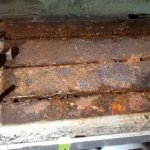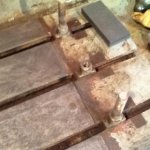jljim
Cast Iron
- Joined
- Jul 24, 2004
- Location
- Northwest Ohio
My recently aquired model B Thompson has a 12x40 chuck. From the center of the chuck to either end it drops about .005 with an indicator on the wheel head. It also drops another .005 from the back to the front edge making a total error to the front outside edges of nearly .010". This error was mirrored in the first test grind using about 10x30 area of the chuck. The indicator test was run with the table way lube supply shut off while slowly traversing the table and the wheel head. I'm thinking I should probably lift the chuck and clean the mounting surfaces before grinding or should I just grind ?






 . The wheel that's mounted is a Norton
. The wheel that's mounted is a Norton 
